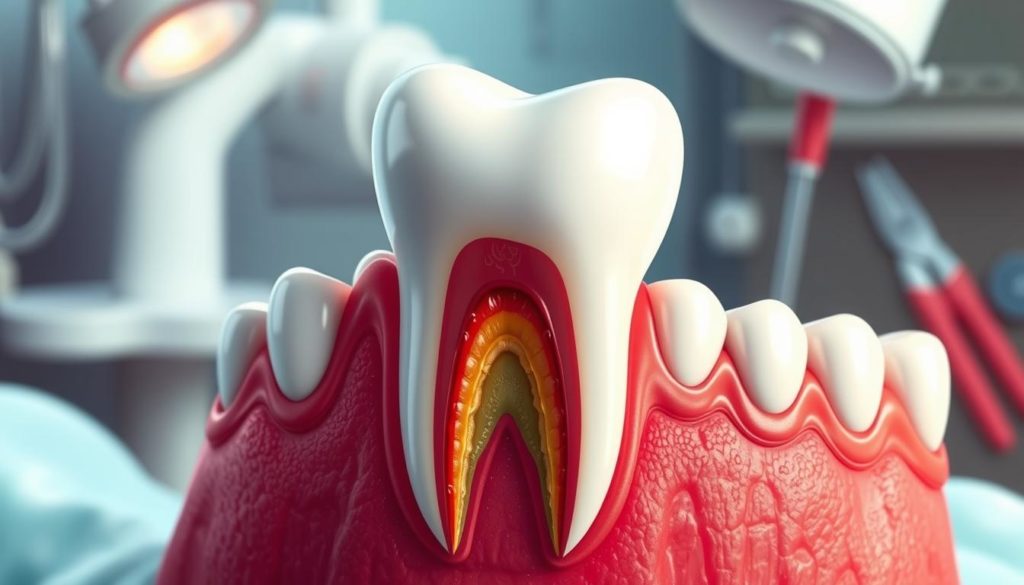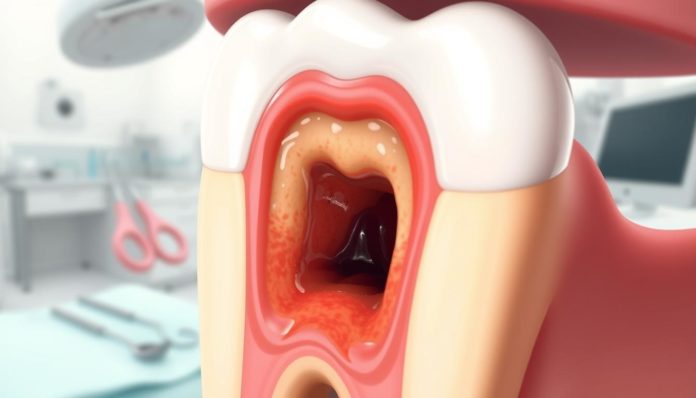Did you know an abscessed tooth impacts up to 12,000 Americans every year? It needs quick medical help. This condition is not just painful; it can be deadly if not treated. An abscessed tooth happens when infection forms a pus-pocket in the gums. This is often due to cavities, injuries, or failed dental work. It’s critical to notice symptoms like severe pain or difficulty breathing early. Then, getting dental abscess treatment quickly is vital.
Knowing the causes and pain relief options for an abscessed tooth is crucial for your oral health. Keep reading to learn about what causes an abscessed tooth. We will also cover its symptoms and the treatments that can save your smile—and possibly your life.
Understanding an Abscessed Tooth
An abscessed tooth happens when bacteria get through the tooth’s enamel, reaching the dental pulp. This is made of nerves and blood vessels. This infection creates a pocket of pus, which can cause a lot of discomfort and other issues.
It’s key to know the signs of an abscessed tooth early. Signs include a bad toothache, feeling pain when you eat hot or cold foods, and swelling in the face or gums. Sometimes, the pain might not start until the problem is very serious.
While seeing a dentist is a must, some try tooth abscess home remedies for quick relief. Rinsing with warm salt water and using pain relievers from the store can help. But, they don’t replace getting professional help.

To avoid the bad effects of not treating an abscessed tooth, knowing and spotting symptoms early is vital. Being good at dental hygiene and getting check-ups can stop and reduce the risks of an abscessed tooth.
What Causes an Abscessed Tooth?

An abscessed tooth is painful due to several factors. These causes lead to an infection inside the tooth. It’s important to know what they are to prevent and treat this dental issue.
Poor Dental Hygiene
Poor dental hygiene is a top reason for an abscessed tooth. Not brushing or flossing enough leads to plaque and tartar. That’s where bacteria grow, causing tooth decay and infection. Keeping up with dental care helps avoid this problem.
High Sugar Diet
Eating too much sugar also leads to cavities. The sugar feeds mouth bacteria, speeding up tooth decay. Deep cavities can lead to an abscess. Eating less sugar and a balanced diet is important for prevention.
Dry Mouth
A dry mouth can cause tooth abscesses, too. Saliva cleans the mouth and fights off bacteria. Not enough saliva, from meds, dehydration, or aging, raises decay and infection risks. It’s key to keep the mouth moist and promote saliva.
| Cause | Impact | Prevention |
|---|---|---|
| Inadequate Oral Hygiene | Leads to plaque and tartar buildup | Regular brushing and flossing |
| High Sugar Diet | Increases risk of cavities | Limit sugar intake |
| Dry Mouth | Less saliva to neutralize acids | Stay hydrated and stimulate saliva |
Symptoms of an Abscessed Tooth
An abscessed tooth is painful and needs fast attention. Spotting the symptoms early can help you get the care you need quickly. This prevents more serious problems.
Severe, Throbbing Pain
Severe, throbbing pain is a major sign of an abscessed tooth. It can spread to your jaw, neck, or ear. This pain might not stop and can ruin your daily life and sleep.
Swelling and Redness
Swelling and redness in your face or cheeks are clear dental infection signs. This swelling can change how you look and make eating hard.
Fever and Swollen Lymph Nodes
Fever and big, sore lymph nodes under your jaw or neck are serious infected tooth symptoms. They mean the infection could be spreading. You need to see a doctor fast.
How to Diagnose an Abscessed Tooth
Figuring out if you have a dental abscess involves a few key steps. A dentist will check your symptoms and do tests to find the problem. It’s good to know what happens so you can handle the abscess quickly.
Dentist Examination
Seeing your dentist is the first move to diagnose an abscessed tooth. They’ll ask about your pain and look for any swelling. They might also tap on your teeth to see which one hurts, checking for sensitivity.
X-rays and CT Scans
Tools like x-rays are very important for finding out about a dental abscess. An x-ray can show how bad the infection is and how it’s affecting areas around it. If things look serious, a CT scan might be needed to get a closer look at the infection. This helps in making a good plan for treatment.
| Diagnostic Method | Purpose | Details |
|---|---|---|
| Examination by Dentist | Initial Assessment | Identifies pain points, swelling, and general oral health. |
| Tooth Infection X-ray | Detailed Imaging | Shows infection spread within the tooth and nearby areas. |
| CT Scan for Abscess | Advanced Imaging | Provides a 3D view of abscess spread, crucial for complex cases. |
Treatment Options for an Abscessed Tooth
Abscessed tooth treatment is vital for easing pain and stopping further problems. Different methods can be used, based on how severe and specific the issue is. Here are the main treatments:
Root Canal Treatment
Root canal therapy is a common cure for tooth infection. It removes the infected inside of the tooth. After that, the area is cleaned, disinfected, and filled. This treatment saves the tooth and brings back its function.
Tooth Extraction
If a tooth is beyond saving, pulling it out might be needed. This gets rid of the infection source and stops it from spreading. After removing the tooth, other procedures like bridges or implants may be needed to fix the dental arch.
Antibiotics
Antibiotics are used when an abscess goes beyond the tooth. They help control the infection. But, they don’t fix the abscess on their own. They’re typically used with other methods, like root canal or tooth removal, to tackle the problem fully.
Abscessed Tooth Home Remedies
Professional treatment is a must for an abscessed tooth. But certain home remedies can provide a bit of relief. They help manage the pain until you see a dentist.
Over-the-Counter Pain Relievers
Pain relievers like ibuprofen can help with tooth abscess pain. They ease inflammation and offer temporary relief. Still, they don’t fight the root infection.
Warm Salt Water Rinse
A warm salt water rinse is a reliable home remedy for a tooth infection. It calms inflamed tissues. It may also keep the infection from spreading for a while.
Avoid Hot or Cold Foods
Stay away from hot or cold foods to manage tooth abscess pain better. Extreme temps can make the pain worse, so choose lukewarm and soft foods.
These remedies can ease symptoms. Yet, it’s key to get a dentist’s care to truly solve the problem.
- Use ibuprofen for pain relief
- Rinse with warm salt water
- Avoid extreme temperatures in food
| Remedy | Benefit | Duration |
|---|---|---|
| Over-the-Counter Pain Relievers | Reduce inflammation | Temporary |
| Warm Salt Water Rinse | Soothe tissues | Temporary |
| Avoid Hot or Cold Foods | Minimize pain | As needed |
When to See a Dentist for an Abscessed Tooth
Knowing when to rush for emergency dental help for an abscessed tooth is key. Being clued in on the important signs can stop more health issues.
Acute Pain or Swelling
If your pain gets worse or you notice swelling, these are signs to watch out for. They mean the infection might be spreading, needing quick action.
High Fever
A constant high fever often comes with an abscessed tooth. This calls for quick help from a dentist to handle the spreading infection.
Difficulty Breathing or Swallowing
Having a hard time breathing or swallowing is serious. It suggests the infection has reached deep areas, needing fast dental help to avoid worse issues.
Preventing an Abscessed Tooth
To avoid the pain and trouble of an abscessed tooth, follow some simple steps. It begins with daily routines that keep your mouth healthy and includes regular dentist visits.
Maintaining Good Oral Hygiene
Good oral hygiene is key to stopping abscessed teeth. Brush your teeth twice a day with fluoride toothpaste and don’t forget to floss. Using a fluoride mouth rinse also helps a lot.
- Brush twice daily with fluoride toothpaste
- Floss daily to remove food particles and plaque
- Use fluoride mouth rinse regularly
Regular Dental Check-Ups
Seeing your dentist often is vital in preventing dental abscesses. They can catch and treat problems early on. Make sure to have a dental check-up and cleaning at least twice a year.
- Schedule dental check-ups every six months
- Get professional cleanings to remove plaque and tartar
- Discuss any concerning symptoms with your dentist
| Preventative Measure | Frequency | Benefits |
|---|---|---|
| Brushing with Fluoride | Twice Daily | Prevents plaque build-up |
| Flossing | Daily | Removes food particles and plaque |
| Fluoride Mouth Rinse | Daily | Strengthens enamel |
| Dental Check-Ups | Every 6 Months | Early identification of issues |
Risks and Complications of an Untreated Abscessed Tooth
If a tooth abscess is not treated, it can cause serious health problems. The biggest risk is the spread of bacteria to nearby areas. This spread can harm the jawbone, throat, and even the face and neck.
Spread of Infection
Ignoring an abscessed tooth lets the bacteria spread to surrounding tissues. This can lead to osteomyelitis, a jawbone infection, or a maxillary sinus infection, which affects spaces behind the cheekbones. The infection can even travel further, causing systemic illnesses like sepsis. It is vital to seek dental care early to prevent these complications. For more information, visit the Mayo Clinic.
Severe Health Consequences
Ludwig’s angina is a severe effect of not treating an abscessed tooth. It causes swelling and inflammation around the throat. This can block the airways and make it hard to breathe. Moreover, a dental infection can become septic, spreading through the bloodstream. Addressing a tooth abscess quickly is crucial to avoid these serious problems.
In summary, the risks of not treating a tooth infection are high. They range from infections spreading to far areas to the threat of life-threatening sepsis. Regular dental visits and good oral hygiene are key to preventing these issues.
FAQ
What causes an abscessed tooth?
Poor oral hygiene, eating too much sugar, and dry mouth can lead to an abscessed tooth. These conditions allow bacteria to infect the tooth’s center.
What are the symptoms of an abscessed tooth?
Signs include throbbing pain, swelling in the face or gums, and fever. You may also have swollen lymph nodes and trouble breathing or swallowing.
How is an abscessed tooth diagnosed?
A dentist will check your tooth, do sensitivity tests, and use X-rays or CT scans. They look to see how far the infection has spread.
What are the treatment options for an abscessed tooth?
Treatment can be a root canal, pulling the tooth, or using antibiotics. The goal is to get rid of the infection and fix the tooth.
Are there home remedies for an abscessed tooth?
Some home treatments include pain relievers, warm saltwater rinses, and avoiding certain foods. Still, you need to see a dentist for real help.
When should I see a dentist for an abscessed tooth?
See a dentist right away if you have bad pain or swelling, a high fever, or trouble breathing or swallowing. These symptoms mean the infection is serious.
How can I prevent an abscessed tooth?
Keep your mouth clean, visit the dentist often, eat less sugar, and drink fluoridated water. These steps help prevent tooth abscesses.
What are the risks and complications of an untreated abscessed tooth?
Not treating an abscess can cause the infection to spread to your jaw, head, neck, or blood, leading to major health problems such as sepsis, osteomyelitis, or Ludwig’s angina.


